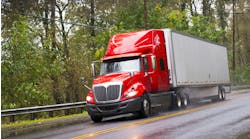You may have had to extend the useful life of your assets because of recent supply chain disruptions that resulted in truck makers allocating the number of trucks fleets were able to procure. But as production ramps up, you should consider reviewing the life cycles of your assets.
Keep in mind that there is no universal agreement on how long a fleet should keep an asset. Duty cycles, operating conditions, and fleets’ goals all factor into the asset life cycle decision. It is also important to keep in mind that different asset classes may have different life cycles so that throughout your fleet you will have assets across a range of ages.
See also: The three pillars of long asset life
There are four key elements that when considered together will help you determine the proper useful life of your assets.
Operating characteristics
It’s likely that there have been changes in your customers’ businesses since the last time you reviewed your operation, and those changes will change the way you operate.
Track annual mileage for each asset as well as average mileage per trip. Also collect information on each asset’s duty cycle including miles spent on highway, miles spent in city, stop-and-go miles, and climate and geographic conditions.
One often overlooked factor is idle time. Equipment with PTO-driven accessories likely idles much more than equipment without a PTO, which can make an apples-to-apples comparison based on odometer readings challenging. Incorporating idle time into the calculation provides a more accurate idea of engine wear and tear.
Examine the service history of your assets including service between preventive maintenance appointments. That will tell you a great deal about the durability of existing assets. Make sure you have a complete understanding of the running cost of your assets and an accurate assessment of what assets are worth at trade-in. Estimating residual value of equipment five, six, or more years into the future is an educated estimate at best.
Market conditions will likely change between the time equipment is ordered and when it is turned in end of useful life. All this information is needed to determine the total cost of ownership (TCO) which then informs asset replacement decisions.
Vehicle specs
Your specs should be based on your assets’ duty cycles but also on your overall operating objectives. This includes fuel economy, safety, sustainability, etc.
You may also want to review powertrain options. There is a range of fuels available to power today’s medium- and heavy-duty trucks. In some applications, it may make sense for you to invest in something other than diesel.
See also: Does trucking’s future still have ICE in its veins?
This is also the time to look at whether it makes sense to own or lease your assets and also whether you should be doing maintenance in-house or outsource maintenance and repair to professionals.
Budget considerations
Set an operating budget and continuously monitor your performance against the budgeted amount. Cost per mile is a good measurement but you can also track costs on a weekly or monthly basis.
When it comes to tracking maintenance and repair costs, Vehicle Maintenance Reporting Standards (VMRS) codes are a good way to see exactly what failures your assets are experiencing as well as which assets are performing well from a service standpoint. This information can be used to fine tune asset specs every time you purchase a new vehicle.
Warranty coverage
All trucks come with basic warranty coverage, but truck makers and component suppliers also offer extended warranties. The number of years you plan to keep your equipment and the amount of idle time or miles that will be accumulated during that time will determine whether extended warranty coverage makes sense for you. Although extended warranties come with a price tag, they can help lower your overall operating costs and help shield you from major component failure expense.
No two fleets operate exactly the same, so there is no universal recommendation on how long to keep an asset in service. Some fleets keep their assets for as little as two years, while others keep them for 10 or more years. By looking at your operating conditions, preferred specs, and budget you can set asset replacement schedules that give you the best TCO.
Gino Fontana, CTP, is COO and EVP at Transervice Logistics Inc. Prior to this, he was VP of operations at Berkeley Division and Puerto Rico. He has more than 35 years of experience in the transportation and logistics industry with both operational and sales experience.



